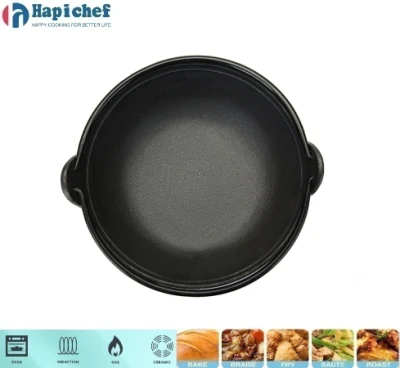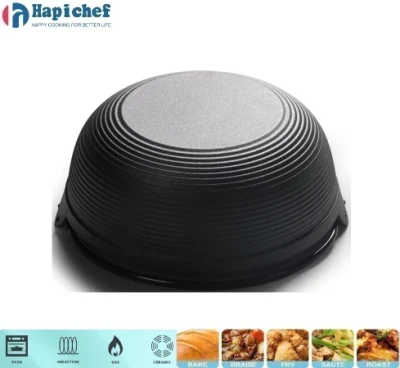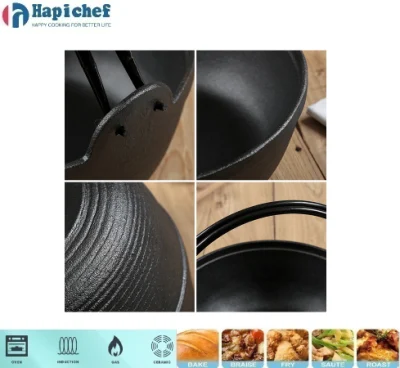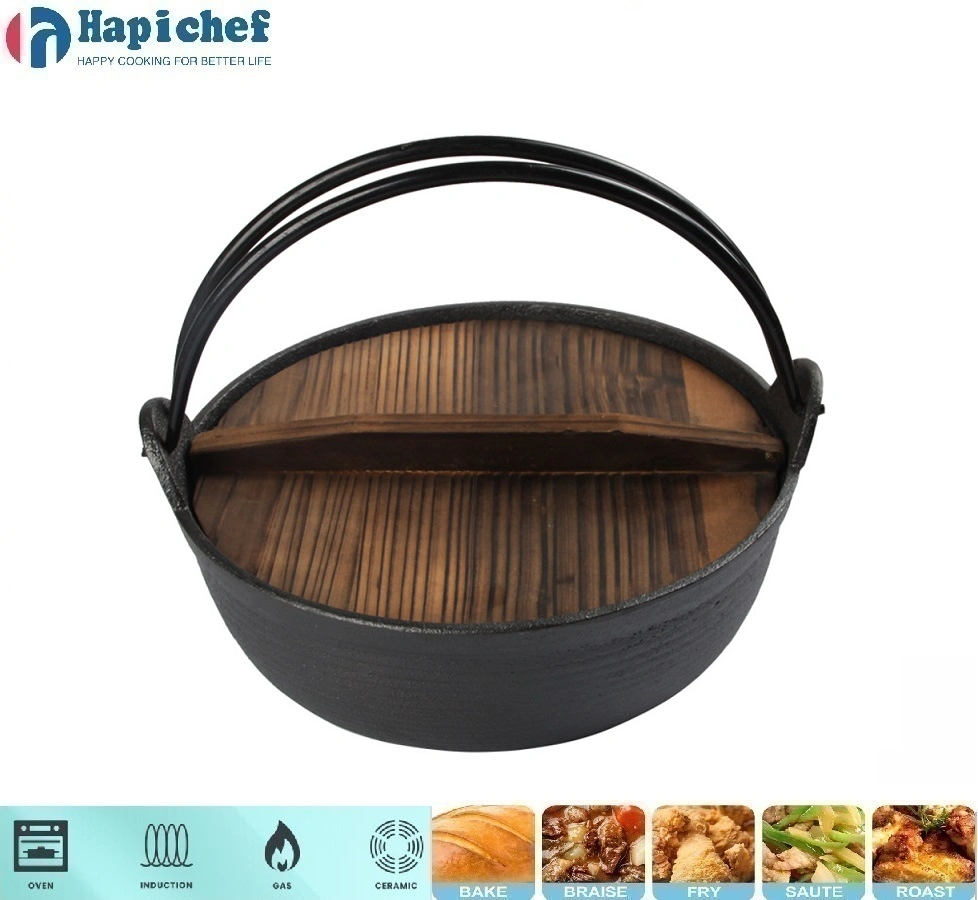Large Cast Iron Wok with Lid for Authentic & Healthy Cooking
Optimizing Commercial Kitchen Operations with Advanced Cast Iron Wok Solutions
In the rigorous environment of professional culinary operations, the selection of durable, high-performance cookware is paramount to efficiency, energy conservation, and culinary excellence. Among the indispensable tools, the cast iron wok with lid stands out as a foundational asset, renowned for its superior thermal properties and robust construction. This comprehensive analysis delves into the technical facets, strategic advantages, and application paradigms of modern cast iron wok systems, specifically engineered for B2B procurement in the food service and hospitality sectors.
Designed to meet the stringent demands of high-volume cooking, these specialized culinary vessels offer unmatched heat retention and uniform heat distribution, critical factors for consistent product quality and operational cost efficiency. Our focus herein is to provide B2B decision-makers and procurement engineers with the in-depth knowledge necessary to make informed investments in cookware that significantly enhance kitchen productivity and longevity.
Manufacturing Process and Quality Assurance for Cast Iron Woks
The production of a high-quality cast iron wok with lid is an intricate process that combines traditional metallurgical techniques with advanced engineering principles to ensure optimal performance and longevity. The lifecycle of these critical kitchen assets commences with meticulous material selection and culminates in rigorous quality control to meet international standards such as ISO 9001 and ANSI specifications.
Process Flow Diagram:
1. Raw Material Sourcing & Preparation: High-purity pig iron and meticulously selected scrap steel, precisely mixed with carbon, silicon, manganese, and trace elements to achieve specific metallurgical properties. Strict adherence to ASTM A48 standards for gray iron castings.
2. Melting & Alloying: Raw materials are melted in induction furnaces at temperatures exceeding 1400°C. Alloying elements are added under controlled atmospheric conditions to ensure homogeneity and desired microstructure, crucial for thermal conductivity and durability.
3. Molding & Casting: Utilizes advanced sand casting techniques, often involving automated molding lines to ensure precise dimensions and intricate designs for the cast iron wok with lid and handle. Molds are prepared with fine-grain sand and binders for superior surface finish and structural integrity.
4. Cooling & Demolding: Castings are allowed to cool gradually within the sand molds to prevent thermal stress and achieve optimal crystal structure. Once cooled, parts are carefully demolded, and excess sand is removed.
5. Post-Casting Treatment (Fettling & Grinding): Rough edges, gates, and risers are removed via grinding and fettling processes. This stage also includes initial visual inspection for surface defects or irregularities.
6. CNC Machining: Precision CNC machining is applied to critical surfaces, such as the base for flatness (ensuring even heat distribution on various stovetops) and the lid's seating area for a tight seal. This enhances ergonomic design and functional performance.
7. Surface Treatment & Seasoning: Products undergo thorough cleaning, followed by application of protective coatings or pre-seasoning. For seasoned cast iron, multiple layers of vegetable oil are baked onto the surface at high temperatures, creating a natural, durable non-stick finish and corrosion resistance. Enamel coating, if specified, involves multiple layers of vitreous enamel baked at high temperatures.
8. Quality Control & Testing: Each unit undergoes multi-stage quality assurance, including material composition analysis (spectroscopy), dimensional checks, hardness testing, thermal shock resistance, and non-stick performance evaluations. Products are tested against ISO 9001 quality management standards and relevant food-contact safety regulations (e.g., FDA compliance for coatings).
9. Assembly & Packaging: Components, including lids and handles, are assembled. Products are then packaged securely to prevent damage during transit, ready for distribution to target industries such as hospitality, catering, and food processing.

The rigorous adherence to these process steps ensures an exceptional service life for a cast iron wok with lid, often exceeding decades in commercial use, making them a sustainable and cost-effective investment for professional kitchens requiring a cast iron wok pot with significant durability.
Industry Trends and Market Dynamics for Commercial Cookware
The commercial kitchen equipment market is undergoing significant evolution, driven by shifts towards greater energy efficiency, sustainability, and enhanced operational versatility. For cookware, this translates into a heightened demand for robust, long-lasting materials that offer superior performance and health benefits. The market for products like the cast iron wok with lid is projected to grow due to these underlying trends.
One key trend is the increasing emphasis on thermal efficiency. With rising energy costs, commercial establishments are actively seeking cookware that can achieve and maintain cooking temperatures with minimal energy input. Cast iron, with its unparalleled heat retention properties, directly addresses this need, leading to considerable energy savings over time. Industry reports indicate that efficient cooking equipment can reduce energy consumption by up to 20% in professional kitchens. Another dominant trend is the focus on food safety and non-toxic materials. The natural seasoning process on cast iron offers a chemical-free non-stick surface, aligning with consumer and regulatory preferences for healthier cooking solutions, as opposed to synthetic coatings which may degrade over time.
Furthermore, the global movement towards sustainable practices is influencing procurement decisions. The inherent durability and extended service life of a cast iron wok with lid minimize replacement cycles, reducing waste and contributing to a more circular economy in the foodservice industry. This longevity, coupled with the recyclability of cast iron, positions it as an environmentally responsible choice for commercial entities.

Technical Specifications and Performance Parameters
The efficacy of a cast iron wok with lid in a commercial setting is directly attributable to its robust technical specifications. Understanding these parameters is crucial for optimizing kitchen performance and ensuring alignment with specific culinary requirements. Key characteristics include material composition, thermal properties, dimensional specifications, and surface treatments.
Product Specification Table: Japanese Cast Iron Sukiyaki Tetsu Nabe Hot Pot with Lid (Example)
| Parameter | Specification | Technical Rationale / Benefit |
|---|---|---|
| Material Composition | High-purity Gray Cast Iron (ASTM A48 Class 30) | Ensures superior thermal mass, excellent heat retention, and durability under high thermal cycling conditions. |
| Thermal Conductivity | ~50 W/(m·K) (typical for cast iron) | Facilitates rapid and even heat distribution across the cooking surface, preventing hot spots. |
| Heat Retention Capacity | Excellent, maintains stable temperature for extended periods. | Reduces energy consumption by maintaining cooking temperatures efficiently, ideal for simmering and braising. |
| Typical Diameter / Capacity | 26 cm (10.25 in) / 3.0 Liters | Offers versatility for various batch sizes; larger models (e.g., a large cast iron wok with lid) available for higher volume requirements. |
| Weight | ~4.5 kg (9.9 lbs) (approx.) | Indicates robust construction and significant thermal mass, contributing to stability on cooktops. |
| Surface Finish | Pre-seasoned with natural vegetable oil (e.g., flaxseed oil) | Provides an immediate natural non-stick surface, enhances corrosion resistance, and improves with use. |
| Lid Material & Fit | Matching Cast Iron, precision-machined fit | Ensures tight seal for moisture retention, steam circulation, and nutrient preservation during cooking. |
| Handle Design | Integrated Cast Iron Side Handles (for a cast iron wok with lid and handle) | Offers secure grip and oven-safe properties; integral design prevents loosening over time. |
| Compatibility | Induction, Gas, Electric, Ceramic, Oven, Grill | Universal applicability across diverse commercial kitchen setups. |

For operations requiring increased volume, options such as a cast iron wok large are available, providing extended capacity without compromising the fundamental thermal benefits of the material. These larger units are particularly beneficial for batch cooking in high-throughput environments.
Key Technical Advantages in Commercial Culinary Operations
The inherent properties of cast iron provide a distinct array of technical advantages that are critically beneficial in professional kitchen settings, setting a cast iron wok with lid apart from alternatives.
- ✓ Superior Heat Retention and Distribution: Cast iron's high thermal mass allows it to absorb and retain heat far more effectively than lighter materials. This translates to remarkably stable cooking temperatures, essential for even searing, simmering, and braising, reducing energy consumption by minimizing fluctuations. For example, a cast iron pan can maintain a surface temperature within a 5°C variance for over 10 minutes after heat removal, while stainless steel often drops by 20°C in the same timeframe. This consistency is crucial for volume cooking.
- ✓ Exceptional Durability and Longevity: Built for rigorous use, cast iron is virtually indestructible under normal kitchen conditions. Its inherent strength provides excellent corrosion resistance when properly maintained and seasoned, offering a service life that can span decades, significantly reducing replacement costs compared to other cookware materials.
- ✓ Natural Non-Stick Properties: Through consistent seasoning, cast iron develops a polymerised oil layer that provides a naturally non-stick cooking surface. Unlike synthetic coatings, this surface improves with use and can be easily restored, eliminating concerns about chemical degradation and ensuring food safety.
- ✓ Versatility Across Cooking Methods: A cast iron wok pot is uniquely adaptable to a multitude of cooking techniques. Its ability to withstand extremely high temperatures makes it ideal for stir-frying, deep-frying, and searing. The tight-fitting lid transforms it into an excellent vessel for braising, stewing, and steaming, consolidating several functions into one essential piece of equipment. Furthermore, its oven-safe construction allows for seamless transitions from stovetop to oven, providing unparalleled flexibility.
- ✓ Nutritional Fortification: A minor, yet notable, advantage is the trace amounts of dietary iron that can leach into food cooked in cast iron. While not a primary source, it can contribute to iron intake, a beneficial aspect particularly relevant in large-scale food preparation.
These advantages collectively position the cast iron wok with lid as a highly strategic investment for any professional kitchen focused on operational efficiency, culinary quality, and long-term sustainability.
Application Scenarios and Case Studies
The robust design and thermal efficiency of a cast iron wok with lid make it an indispensable tool across a diverse range of commercial and industrial food preparation environments. Its versatility extends from high-volume restaurant kitchens to specialized food processing facilities.
Typical Application Scenarios:
- ● High-Volume Restaurants & Hotel Kitchens: Ideal for stir-frying large batches of ingredients, simmering sauces, braising meats, and preparing stews due to consistent heat and robust construction. The ability to handle high temperatures is critical for rapid service.
- ● Catering Services: Excellent for cooking and holding food at optimal serving temperatures, given cast iron's superior heat retention. Facilitates preparation of versatile dishes for events, ensuring quality from kitchen to serving line.
- ● Industrial & Institutional Food Service (e.g., Hospitals, Schools): Used for preparing large quantities of nutritious meals. The durability reduces the frequency of equipment replacement, and consistent cooking ensures dietary quality.
- ● Specialty Food Production & Processing: Applicable for specific batch processes, such as reducing sauces, creating jams, or preparing specialized ethnic cuisine components, where precise temperature control and non-reactive surfaces are paramount.
Application Case Study: High-Volume Stir-Fry Station
A prominent chain of Asian fusion restaurants faced challenges with inconsistent stir-fry quality and high energy consumption using traditional stainless steel woks. Their primary issue was maintaining sufficiently high and stable temperatures across the wok's surface for rapid, even cooking of large portions, leading to "steamed" rather than "seared" results and increased cooking times.
Solution: The chain integrated large cast iron wok with lid units into their stir-fry stations. These woks, specified for a 36 cm diameter and pre-seasoned finish, were chosen for their superior thermal mass and ability to retain high heat. The accompanying lids were crucial for occasional steaming or holding.
Results:
- ✔ Improved Culinary Quality: The uniform high heat allowed for perfect caramelization and searing of ingredients, significantly enhancing flavor and texture profiles. Customer feedback on stir-fry dishes showed a 15% increase in satisfaction scores related to texture and taste.
- ✔ Energy Efficiency: Initial energy audits revealed a 12% reduction in energy consumption at stir-fry stations due to the cast iron's ability to retain heat and require less continuous energy input to maintain temperature.
- ✔ Increased Throughput: Faster cooking times per batch, combined with reliable performance, led to a 10% increase in the number of stir-fry dishes prepared during peak hours, directly impacting revenue.
- ✔ Reduced Maintenance & Replacement Costs: After 24 months, the cast iron woks showed minimal wear compared to previous stainless steel models that required frequent replacement due to warping and staining.

This case demonstrates how selecting the appropriate cast iron wok pot can translate into tangible operational and financial benefits, reinforcing the value of strategic equipment procurement.
Vendor Comparison and Strategic Procurement
Selecting a supplier for specialized cookware like a cast iron wok with lid requires a diligent evaluation process extending beyond initial cost. Key considerations include manufacturing quality, adherence to international standards, post-sale support, and the ability to provide customized solutions. Below is a comparative overview to guide procurement decisions.
Comparative Analysis: HapiChef vs. Competitor A vs. Competitor B
| Feature/Criterion | HapiChef Cookware | Competitor A (Premium) | Competitor B (Value) |
|---|---|---|---|
| Material Purity & Sourcing | High-grade virgin cast iron, certified (ISO 9001, FDA compliant finishes) | Premium cast iron, often proprietary blends, certified (e.g., EU Food Contact Safe) | Standard cast iron, variable sourcing, basic compliance |
| Manufacturing Precision | Advanced casting & CNC machining for optimal flatness & lid fit | Exceptional precision, hand-finished elements | Standard casting, manual finishing for basic function |
| Surface Treatment (Seasoning) | Multi-layer natural oil pre-seasoning, oven baked for durability | Proprietary seasoning process, often with detailed care instructions | Basic pre-seasoning, may require immediate additional seasoning |
| Warranty & Service Life | 10-year commercial warranty, estimated 25+ year service life | Lifetime limited warranty, estimated 30+ year service life | 1-year standard warranty, estimated 5-10 year service life |
| Customization Options | ODM/OEM available (size, handle, finish, branding) | Limited customization for branding, high MOQ | Generally off-the-shelf products only |
| Price Point (relative) | Mid-to-High (Excellent Value) | Premium (Highest) | Economy (Lowest) |

This comparison highlights that while budget options exist, investing in a quality cast iron wok with lid from a reputable manufacturer like HapiChef Cookware provides a superior balance of performance, durability, and long-term cost-effectiveness. The total cost of ownership (TCO) for a higher-quality unit is often significantly lower due to reduced replacement rates and energy savings.
Customized Solutions and Tailored Offerings
Recognizing that commercial culinary operations often have unique requirements, leading manufacturers offer bespoke solutions for their cast iron wok with lid product lines. These customization capabilities ensure that cookware perfectly integrates with specific kitchen layouts, operational workflows, and branding strategies.
Our OEM (Original Equipment Manufacturer) and ODM (Original Design Manufacturer) services provide extensive flexibility. This includes, but is not limited to, modifications in size (e.g., specialized dimensions for a cast iron wok large), handle configurations (such as ergonomic designs for a cast iron wok with lid and handle that optimize grip and balance), specific surface finishes (e.g., custom seasoning types or enamel colors), and integration of client branding or logos directly onto the product. Such tailored solutions are critical for large-scale procurement where standardization across multiple locations or adherence to specific aesthetic and functional criteria is paramount. Minimum Order Quantities (MOQs) apply for customized projects, ensuring efficient production runs that benefit from economies of scale.
Trustworthiness: FAQs, Fulfillment, Warranty, and Support
Building trust with B2B clients is foundational. This section addresses common inquiries and outlines our commitment to transparency, timely fulfillment, robust warranty, and comprehensive post-sales support for every cast iron wok with lid supplied.
Frequently Asked Questions (FAQs):
Q: What is the typical lead time for a bulk order of cast iron woks?
A: Standard product lead times typically range from 4-6 weeks for bulk orders, depending on order volume and current production schedules. For customized solutions (OEM/ODM), lead times may extend to 8-12 weeks to accommodate design, tooling, and specialized production processes. Specific timelines will be provided with your formal quotation.
Q: How do I maintain my cast iron wok to ensure maximum longevity?
A: Proper maintenance is key to cast iron's extended service life. Always hand wash with warm water and a stiff brush (avoid harsh detergents), then immediately dry thoroughly to prevent rust. Re-season periodically with a thin layer of cooking oil. Detailed care instructions are provided with each order and are available on our website.
Q: Are your cast iron products certified for food safety?
A: Yes, all our cast iron products are manufactured using food-grade materials and processes, adhering to international food safety standards. Our pre-seasoning oils are FDA-compliant, and our manufacturing facilities operate under ISO 9001 quality management systems, ensuring product integrity and safety for professional culinary applications.
Q: What is your warranty policy for commercial cast iron cookware?
A: We offer a 10-year limited commercial warranty against manufacturing defects for our cast iron wok with lid and related products. This warranty covers defects in material and workmanship under normal commercial use. Specific terms and conditions are detailed in our warranty documentation.
Q: Do you provide technical support or training for kitchen staff on cast iron use?
A: While comprehensive training is typically not required, we offer resources including detailed user guides, maintenance manuals, and direct technical support via phone or email to address any operational queries. For large-scale deployments, we can arrange informational sessions as needed.
Lead Time & Fulfillment:
Our supply chain is optimized for efficiency and reliability. We maintain strategic inventory levels for standard products and leverage robust manufacturing capabilities for larger or custom orders. Fulfillment processes include rigorous pre-shipment inspections and professional packaging to ensure products arrive in pristine condition, ready for immediate deployment in your commercial kitchen. Global shipping capabilities are supported by established logistics partnerships.
Warranty Commitments:
Our commitment to quality is underscored by our comprehensive warranty. Every cast iron wok with lid is manufactured to exacting standards. Should any defect arise under normal operating conditions within the warranty period, we are committed to repair or replacement, ensuring your investment is protected. This reflects our confidence in the durability and craftsmanship of our products.
Customer Support & After-Sales Service:
Our dedicated B2B customer support team is available to assist with technical inquiries, order tracking, and post-sales support. We prioritize prompt and effective communication to minimize downtime and ensure seamless integration of our cookware into your operations. Our reputation is built on long-term partnerships and unwavering client satisfaction.

Conclusion: A Strategic Investment for Culinary Excellence
The strategic procurement of a high-quality cast iron wok with lid represents a significant investment in the operational efficiency, culinary capabilities, and long-term sustainability of any commercial kitchen. From its meticulous manufacturing process, emphasizing high-purity materials and precision engineering, to its unparalleled thermal properties and durability, this essential piece of cookware delivers tangible benefits that directly impact bottom-line performance.
By aligning with industry trends towards energy efficiency and sustainable practices, while offering the versatility required for diverse culinary applications, a cast iron wok pot stands as a testament to intelligent equipment choices. Our commitment to meeting rigorous technical specifications, coupled with comprehensive support and customization options, ensures that B2B clients receive not just a product, but a reliable solution that contributes to their ongoing success and culinary excellence.
Invest in the lasting performance and proven advantages of advanced cast iron cookware to elevate your professional kitchen operations.
References
- American Society for Testing and Materials (ASTM). ASTM A48/A48M - 03(2022) Standard Specification for Gray Iron Castings.
- International Organization for Standardization (ISO). ISO 9001:2015 - Quality management systems — Requirements.
- Food and Drug Administration (FDA). Code of Federal Regulations, Title 21, Chapter I, Subchapter B - Food for Human Consumption. (Relevant sections for food contact materials and coatings).
- United States Department of Energy (DOE). "Energy Efficiency in Commercial Kitchens." Report on commercial food service equipment energy use.
- Journal of Food Engineering. "Thermal Performance Analysis of Different Cookware Materials for Energy Efficiency in Cooking Applications."
-
hapichefs-casserole-cast-iron-cookware-symphonyNewsAug.23,2025
-
casserole-cast-iron-cookware-in-a-modern-art-installationNewsAug.23,2025
-
hapichefs-molten-artistry-portable-cast-iron-bbq-grill-birthNewsAug.23,2025
-
forging-flavor-in-acast-iron-bbq-grills-fireNewsAug.23,2025
-
hapichefs-enameled-cast-iron-bakeware-a-chefs-museNewsAug.23,2025
-
why-colorful-enameled-cast-iron-bakeware-improves-meal-tasteNewsAug.23,2025
-
Unleash Your Culinary Creativity with Specialized Roasting and Baking PansNewsAug.20,2025
